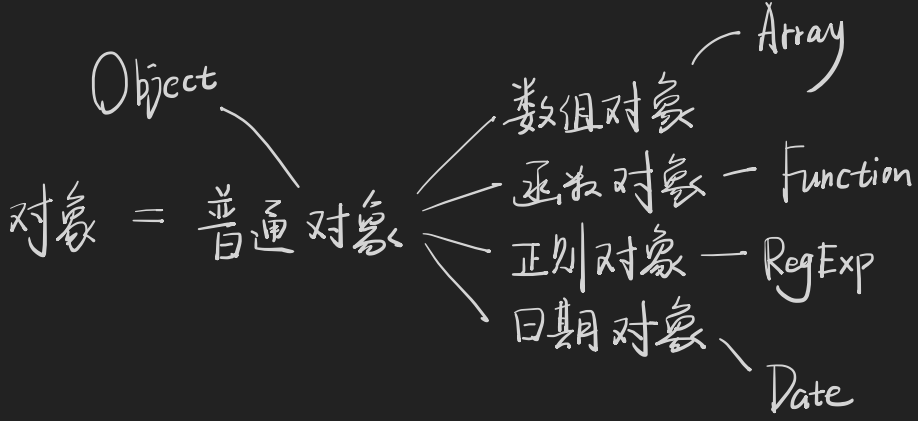TS/JS中有哪些数据类型
- JS——datatype:
null、undefined、string、number、boolean、bigint、symbol、object(含Array、Function、Date...) - TS——dataype:js所有,加上
void、never、enum、unknown、any,再加上自定义类型type、interface
如何理解TS的数据类型
以集合的方式来理解TS类型。
type number = 1 | 1.1 | 1.22 | .....
type string = 'a'|'v'| ..
type boolean = true | false
type Object = { ? } | Array | Function | String | Number | Boolean | RegExp | ...
// 一个对应的是值 一个是类型为什么会有两个number、两个string、两个boolean呢?
这是因为JS有一个包装对象的操作
(42).toFixed(2)
// 为什么42可以直接调用函数方法
// 这是因为JS自己做了一层包装,其实是在运行如下的代码
let temp = new Number(42) //
value = temp.toFixed(2)
// 之后在删除temp,返回value值所以JS中的Number、String、Boolean 只用于包装对象,在TS里也不用。可以发现Object的范围以很大,所以TS内不使用Object。
如何在TS描述对象的数据类型

由于对象还分很多类型,所以可以采用下面两种方式描述对象的datatype。
- 用
class/constructor描述(不推荐使用) - 用
type或interface描述(建议使用)
普通对象
TS写法的索引签名描述对象,如下所示A表示key为string,value为number的所有对象(k可以换成任意单词)。
type A = {
[k: string]: number
}
// 另一种写法 范型
type A = Record<string, number>
const a: A = {
age: 18
}key的类型可以不是string,也可以是其他类型,由于object太不精确了,所以TS一般采用索引签名或者Record泛型来描述普通对象。
数组对象如何描述?
type A = string[]
// 等价于
type A = Array<string>
const a: A = ['h', 'i']
type B = number[]
// 等价于
type B = Array<number>
const b:B = [42, 0.8]
type D = [string, number]
// 二元组
const d: D = ['a', 100]
type E = [string, string, string]
// 三元组
const noError: E = ['a','b','c']
const error: E = ['a','b'] // 报错
type F = [string[], number[]]
const f: F = [['a','b','c'],[1,2,3]]
type A = [1,2,3]
const a: A = [1,2,3]由于Array太不精确所以一般采用Array<?>或string[]或[string,number]来描述数组。
函数对象如何描述?
具体配置需要在ts.config.json内配置。
type FnA = (a: number, b: number) => number
type FnB = (x: string, y: string) => string
type FnReturnVoid = (s: string) => void
type FnRetrunUndefined = (s: string) => undefined
const v: FnReturnVoid = (s: string) => {
console.log(s)
}
const u:FnReturnUndefined = (s: string) => {
console.log(s)
return undefined
}
// this 类型 必须为普通函数,箭头函数不支持this
type Person = {name: string;age: number;sayHi: FnWithThis}
type FnWithThis = (this: Person, name: string) => void
const sayHi: FnWithThis = function() {
console.log('hi'+ this.name)
}
const x: Person = {name: 'baizhe',age: 18,sayHi: SayHi}
x.sayHi('jack')
sayHi.call(x,'jack')由于Function太不精确,所以使用()=> ?来描述函数,其他对象一般直接用class描述。
其他对象如何描述?
const d: Date = new Date()
const r: RegExp = /ab+c/
const r2:RegExp = new RegExp('ab+c')
const m:Map<string, number> = new Map()
m.set('1',2)
const wm:WeakMap<{name:string},number> = new WeakMap()
// WeakMap 的key必定为一个对象,是复杂类型的
const s: Set<number> = new Set()
s.add(123)
const wx:WeakSet<string[]> = new WeakSet()
// WeakSet 的key必定为一个对象,也是复杂类型any、unknown、never是什么?
any和unknown的区别
any的类型是什么类型都可以,unknown则是未知的,类型也是未知的,使用的时候会报错,可以通过断言的形式来定义类型,适合从外部获取的值(ajax请求获取到的内容),一般推荐使用unknow,any无法使用断言了。
const a:unknown = 1
console.log(a)
a.toFixed(2) // error
const a:unknow = 2
const b = (a as number)never类型怎么用?
never可以理解为空集,any则为全集,unknow则为未知集,never一般用于类型检查,比如用来接ajax请求来的内容。
type A = string & number // 不存在这种类型
type B = stirng | number | boolean
const b: B = ('hello' as any)
if(typeof b === 'string') {
a.split('')
} else if(typeof b === 'number') {
a.toFixed(2)
} else if(typeof b === 'boolean') {
a.valueOf()
} else {
console.log('never')
}